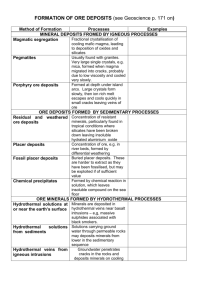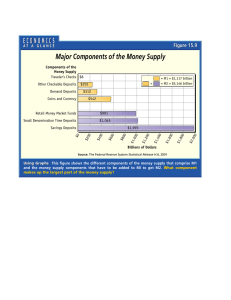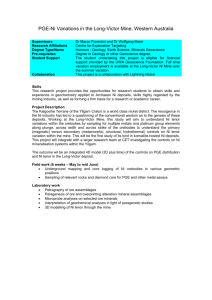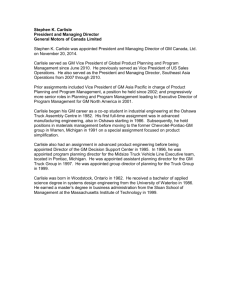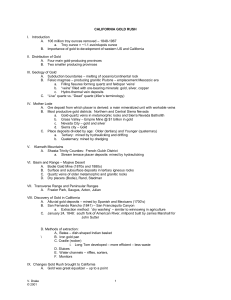Geochemistry and statistical analyses of epithermal veins at the Carlisle
advertisement
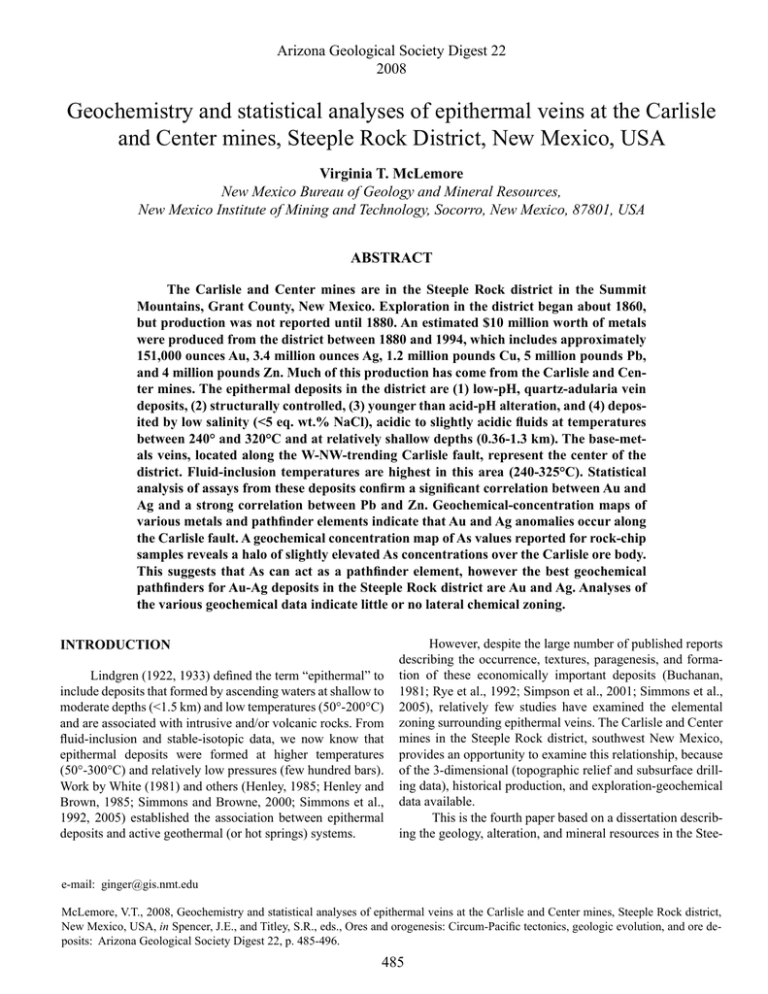
Arizona Geological Society Digest 22 2008 Geochemistry and statistical analyses of epithermal veins at the Carlisle and Center mines, Steeple Rock District, New Mexico, USA Virginia T. McLemore New Mexico Bureau of Geology and Mineral Resources, New Mexico Institute of Mining and Technology, Socorro, New Mexico, 87801, USA ABSTRACT The Carlisle and Center mines are in the Steeple Rock district in the Summit Mountains, Grant County, New Mexico. Exploration in the district began about 1860, but production was not reported until 1880. An estimated $10 million worth of metals were produced from the district between 1880 and 1994, which includes approximately 151,000 ounces Au, 3.4 million ounces Ag, 1.2 million pounds Cu, 5 million pounds Pb, and 4 million pounds Zn. Much of this production has come from the Carlisle and Center mines. The epithermal deposits in the district are (1) low-pH, quartz-adularia vein deposits, (2) structurally controlled, (3) younger than acid-pH alteration, and (4) deposited by low salinity (<5 eq. wt.% NaCl), acidic to slightly acidic fluids at temperatures between 240° and 320°C and at relatively shallow depths (0.36-1.3 km). The base-metals veins, located along the W-NW-trending Carlisle fault, represent the center of the district. Fluid-inclusion temperatures are highest in this area (240-325°C). Statistical analysis of assays from these deposits confirm a significant correlation between Au and Ag and a strong correlation between Pb and Zn. Geochemical-concentration maps of various metals and pathfinder elements indicate that Au and Ag anomalies occur along the Carlisle fault. A geochemical concentration map of As values reported for rock-chip samples reveals a halo of slightly elevated As concentrations over the Carlisle ore body. This suggests that As can act as a pathfinder element, however the best geochemical pathfinders for Au-Ag deposits in the Steeple Rock district are Au and Ag. Analyses of the various geochemical data indicate little or no lateral chemical zoning. INTRODUCTION Lindgren (1922, 1933) defined the term “epithermal” to include deposits that formed by ascending waters at shallow to moderate depths (<1.5 km) and low temperatures (50°-200°C) and are associated with intrusive and/or volcanic rocks. From fluid-inclusion and stable-isotopic data, we now know that epithermal deposits were formed at higher temperatures (50°-300°C) and relatively low pressures (few hundred bars). Work by White (1981) and others (Henley, 1985; Henley and Brown, 1985; Simmons and Browne, 2000; Simmons et al., 1992, 2005) established the association between epithermal deposits and active geothermal (or hot springs) systems. However, despite the large number of published reports describing the occurrence, textures, paragenesis, and formation of these economically important deposits (Buchanan, 1981; Rye et al., 1992; Simpson et al., 2001; Simmons et al., 2005), relatively few studies have examined the elemental zoning surrounding epithermal veins. The Carlisle and Center mines in the Steeple Rock district, southwest New Mexico, provides an opportunity to examine this relationship, because of the 3-dimensional (topographic relief and subsurface drilling data), historical production, and exploration-geochemical data available. This is the fourth paper based on a dissertation describing the geology, alteration, and mineral resources in the Stee- e-mail: ginger@gis.nmt.edu McLemore, V.T., 2008, Geochemistry and statistical analyses of epithermal veins at the Carlisle and Center mines, Steeple Rock district, New Mexico, USA, in Spencer, J.E., and Titley, S.R., eds., Ores and orogenesis: Circum-Pacific tectonics, geologic evolution, and ore deposits: Arizona Geological Society Digest 22, p. 485-496. 485 486 V.T. McLemore ple Rock district (McLemore, 1993). McLemore et al. (2000) described the volcanic geology of the district. McLemore (1996) described the mineral zoning based upon fluid inclusion analyses. McLemore (2000) described the relationship of the alteration assemblages to the mineralization in the district. The purpose of this paper is to present geologic and geochemical data that can be used to (1) determine elemental zoning at the Carlisle and Center mines, (2) provide an exploration model for epithermal deposits with similar characteristics to the Carlisle and Center mines, and (3) enhance current understanding of the processes involved in forming epithermal deposits. LOCATION AND MINING HISTORY The Carlisle and Center mines are in the center of the Steeple Rock district, Grant County, New Mexico (Fig. 1). Exploration in the district began at the Carlisle mine about 1860, but production was not reported until 1880. An estimated $10 million worth of metals were produced from the district between 1880 and 1994 (151,000 oz. Au, 3.4 million oz. Ag, 1.2 million lbs. Cu, 5 million lbs. Pb, 4 million lbs. Zn). Much of this production was from the Carlisle and Center mines. From 1970 to 1994, exploration for Au-Ag intensified, resulting in additional drilling and some production, mainly for silica flux for local copper smelters. There have been no active mines in the district since 1994. The Center mine, owned by Mount Royal Mining Co., was active until early 1994. Doug Hanson built a mill at the Center mine about 1998, but the mill only produced a few test shipments from stockpiles remaining from earlier production. The current increase in demand and price for precious and base metals have renewed interest in the district. Santa Fe Gold Corp. (formerly Azco Mining Inc.) acquired the Summit properties in May 2006 from Biron Bay Resources Ltd. and plan to develop the deposit. Micrex Development Corp. acquired the Banks and Mt. Royal properties and plans exploratory drilling on both properties to evaluate the resource potential. DESCRIPTION OF GEOLOGY The Steeple Rock district lies in a tectonically active and structurally complex area in the southwestern USA that is known for a variety of mineral deposits types (Fig. 1). Laramide compressional deformation (Late Cretaceous-Early Tertiary) related to the behavior of the lithospheric plates subducted beneath southwestern North America, formed a series of N- to NWtrending uplifts and basins in the American Southwest (Seager et al., 1986; Drewes, 1991). This structural trend persists into the mid-Tertiary. Arc magmatism Figure 1. Regional structural features in SW US (A) and the MogollonDatil volcanic field (B) (McIntosh et al., 1992a, b; Chapin et al., 1978). ML—Morenci lineament, JL—Jemez lineament, SRL—Santa Rita lineament, TL—Texas lineament, M—Morenci porphyry copper deposit, S—Safford porphyry copper deposit. Small box (sr) is the approximate location of the Steeple Rock district. Sims et al. (2002) define the area bounded by SRL and JL-SRL as the New Mexico structural zone. Epithermal veins, Steeple Rock district, New Mexico, USA migrated eastward as subduction of the Farallon plate beneath North America continued (Coney and Reynolds, 1977; Dickinson, 1981) and resulted in the intrusion of numerous Laramide porphyry copper deposits in Arizona and New Mexico. Starting at about 40-50 Ma, extensive intermediate to silicic calc-alkaline volcanism and associated plutonism occurred throughout the area that resulted in major andesitic to basaltic volcanic centers and numerous calderas. The Steeple Rock district lies within the Mogollon-Datil volcanic field, which is the northern tip of a regional late Eocene-Oligocene volcanic province that ranges from New Mexico southward into Chihuahua, Mexico (Fig. 1; McDowell and Claubaugh, 1979; McIntosh et al., 1992a, b). At least four ignimbrites 487 crop out in the Steeple Rock district as outflow sheets from distal calderas (Appelt, 1993; McLemore et al., 2000). There is no structural or lithologic evidence to support the presence of a caldera in the Steeple Rock area, contrary to earlier interpretations (Biggerstaff, 1974; Elston, 1978). The structural trend in the district is predominantly NWto W-NW (Fig. 2), which subparallels the Texas lineament (Fig. 1). The Morenci lineament lies north of the district; the Santa Rita lineament is to the south. These regional lineaments appear to control the emplacement of many intrusive and volcanic centers associated with mineral districts in New Mexico, and this area has been called the New Mexico structural zone by Sims et al. (2002). Figure 2. Mines, prospects, and major faults in the Steeple Rock district. 488 V.T. McLemore The Steeple Rock district consists of a series of Oligocene to Miocene basaltic andesitic to dacitic flows interbedded with volcaniclastic sedimentary rocks, ignimbrites, and rhyolite lavas (approximately 2-3 km thick) that are intruded by rhyolite dikes, plugs, and domes (Fig. 2; McLemore et al., 2000). Volcanic activity occurred in the area almost continuously from 34 to 17 Ma and became progressively more silicic with time (McLemore et al., 2000). The oldest volcanic rocks crop out in the southernmost portion of the district and the rocks decrease in age to the N-NE (Fig. 2; McLemore, 1993; Hedlund, 1990a, b, c, d, 1993). Carlisle fault The Carlisle fault is the major W-NW-striking fault in the district (Fig. 2). The strike ranges from N75°W to N85°E, dips 60-70°S, and is downthrown to the south. It varies in width from less than 1 to 30 m. The fault can be traced from the East Camp-Summit fault westward past Laura Canyon, where it curves NW. Locally, two parallel or subparallel fractures are present. Bends in the Carlisle fault, produced by intersection of other faults, localized mineralization. DESCRIPTION OF MINERAL DEPOSITS IN THE DISTRICT Description of veins In the Steeple Rock district, there are 6 distinct types of ore deposit that are spatially related to two types of alteration assemblages (1) acid-pH (alunite, kaolinite, quartz or acid-sulfate) and (2) neutral-pH (propylitic to sericitic). The vein deposits occur exclusively along faults and fractures and along, or cutting across, rhyolite dikes and plugs, which are fault-controlled. The veins typically form prominent outcrops and are bifurcating, sinuous, and pinch and swell along strike. Complex vein textures, especially brecciation, rhythmic layering, and colloform to crustiform banding, are typically associated with high metal concentrations, although many complexly-textured veins are barren. The presence of adularia, bladed calcite, and quartz pseudomorphs after bladed calcite are evidence of local boiling (Browne and Ellis, 1970; Browne, 1978; Hedenquist, 1991; Simmons and Browne, 2000). At least four stages of mineralization separated by periods of brecciation occurred: stage 1, stage 2, stage 3, and late stage mineralization (Fig. 3). The vein deposits can be grouped according to predominant mineralogy as base-metal (Ag, ±Au), Au-Ag (±base metals), Cu-Ag, fluorite, and Mn deposits. A sixth type of deposit, high-sulfidation disseminated Au deposits, also are found in areas of acid-sulfate alteration, but are not fault controlled. The district has been examined for Mo, porphyry Cu, clay, alunite, and U, without any encouraging results. The age of the vein deposits in the district is problematical. Wahl (1983) reports a K-Ar age on adularia from the East Camp vein as 18 Ma. Veins cut the Bloodgood Can- yon Tuff and younger ash-flow tuffs and therefore must be younger than 27 Ma. Thus the age of volcanic-epithermal vein deposits ranges from 18 to 27 Ma, which is similar to the range of ages of rhyolite dikes, domes, and plugs in the area (McLemore, 1993). Base-metal veins The base-metal veins in the district are found along the Carlisle fault, from the Carlisle mine eastward to the Ontario mine (Fig. 4). These veins consist of 5-20% sulfides (galena, sphalerite, chalcopyrite) with Ag (typically 1-8 oz/ton) and Au (typically 0.1-0.4 oz/ton, up to 5 oz/ton) and local secondary minerals (quartz, pyrite, chlorite, illite/sericite, adularia, calcite, kaolinite). Sulfides vary in concentration throughout the fault zone, as they are found in several ore shoots and appear to increase with depth, then decrease near the base of the mineralized ore shoot. Fluid inclusion temperatures are highest in this area (240-325°C; McLemore, 1996). The ore occurs as (1) coarse-grained, massive sulfides, locally with little quartz, and (2) medium- to fine-grained sulfides disseminated throughout brecciated quartz veins and fault gouge. Sulfides in the massive zone occur as streaks, irregular masses, and veinlets in zones up to 4 m wide. At least 3 periods of brecciation and cementation by silica have occurred (Fig. 3). Sulfides are found in stage 2 mineralization and locally in stage 3. Alteration is variable but typically silicification, chloritization, and clay alteration are well developed adjacent to and between the veins. Acid-pH alteration of adjacent host is found at the surface at the Carlisle and Ontario mines (Fig. 4). Au-Ag veins The precious-metal veins in the district consist of quartz, calcite, chlorite, illite/smectite, adularia, epidote, and additional accessory minerals with disseminated Au and Ag and local, but minor, sulfides (<1% pyrite, galena, sphalerite, chalcopyrite). These veins are predominantly quartz and quartz breccias and occur along the NW-striking faults, but they can occur along any fault trace. They are variable in size, rarely exceeding 30 m wide and as much as several hundred meters long. These veins grade locally along strike into the Carlisle base-metal veins, fluorite veins, and Cu-Ag veins. Base-metal sulfides increase with depth in many of these deposits, with total base metals rarely exceeding 1-3%. Au and Ag assays are variable. The best Au-Ag values occur in complex veins. At least three periods of brecciation and cementation by silica have occurred in many areas. Au-Ag occur in stage 2 and locally in stage 3 (Fig. 3). Lattice textures are locally common. A staining of mottramite (Cu,Zn)Pb(VO4)(OH) and/or mimetite Pb5(AsO4,PO4)3Cl is characteristic of higher values of gold and silver. Epithermal veins, Steeple Rock district, New Mexico, USA 489 Figure 3. Simplified paragenetic sequence of events in the Steeple Rock district (from McLemore, 1993, 1996). Cu-Ag veins The Cu-Ag veins are characterized by secondary Cu minerals, predominantly malachite, pseudomalachite and other secondary copper minerals, with detectable Ag concentrations (typically <12 oz/ton; McLemore, 1993) and rare Au concentrations. These veins are sporadically distributed throughout the district and locally grade laterally and vertically into Au-Ag or fluorite veins. The Cu-Ag veins have not been major producers of ore, although some deposits have yielded minor production of Cu and Ag in the past. The CuAg veins are typically short, a few tens of meters in length. The Cu-Ag veins are simple fissure-filling or fracture-coating deposits with only one period of brecciation. Fluorite veins The fluorite veins in the Steeple Rock district are found along the western edge of the district and along Bitter Creek (Fig. 2). These veins are typically simple fissure-filling or fracture-coating fluorite, with minor quartz and calcite. In general, they occur along splays of major faults and along minor faults and vary in width and length. 490 V.T. McLemore deposits of fine-grained Au disseminated in the host rock also are common (White and Hedenquist, 1990). The intense acid-pH alteration cropping out locally in the Steeple Rock area, including the Carlisle mine, indicates a potential for similar Au deposits. Although no economic disseminated Au deposits have been found in the Steeple Rock area, at least two companies (Pioneer Nuclear and FMC) have drilled in altered areas, presumably exploring for similar deposits. Although drilling is inconclusive, a few assays of drill core indicate Au in the acid-sulfate altered areas. Furthermore, surface samples collected by McLemore (1993, 2000) also contain Au locally and are indicative of disseminated Au deposits. DESCRIPTION OF THE CARLISLE AND ­CENTER MINES Carlisle mine Figure 4. Geologic map and cross section of the Carlisle-Center area. Manganese veins Manganese oxides, typically psilomelane, are found as latestage coatings along with other vein minerals throughout the district. Locally, Mn oxides form thin veins and fracture-fillings up to 10 cm thick and several tens of meters long. The Black Cat deposit in the Foothills fault area is the single locality where Mn was mined and produced in the 1950s. This zone is up to 3-5 m wide. Disseminated Au deposits Disseminated Au deposits (high sulfidation) are associated with acid-pH altered rocks in several districts in the world, such as Round Mountain (Tingley and Berger, 1985), Summitville (Perkins and Nieman, 1983; Rye et al., 1992) and El Indio (Walthier et al., 1982). These deposits are characterized by Au, pyrite, and enargite in vuggy silica, veinlets, stockworks, and breccias in zones of acid-pH altered rocks. Bonanza veins are common, but The principal mine in the district is the Carlisle mine (Figs. 2, 4). Descriptions of drill core and mine maps are in McLemore (1993). The Carlisle mine, now flooded, consists of a 3-compartment shaft (157 m deep) with a winze on the 152-m level to 219 m total depth. An open pit with a decline connects to the 12-m level (Fig. 4). The Carlisle ore bodies occur at the junction of the W-NW-trending Carlisle fault and the NW-trending Apache fault. The host rock is altered andesite and andesite porphyry of the Summit Mountain Formation. The ore bodies occur in 1 to 3 major breccia veins. The surface ore minerals include oxidized Cu and Pb minerals, whereas galena, sphalerite, chalcopyrite, bornite, and chalcocite are found deeper in the mine. Ore shoots are pods, stringers, and irregular masses within the breccia veins. Some shoots were up to 2.4 m wide and 61 m long (Gillerman, 1964). Base-metal concentrations increased with depth to the 213-m level. Drilling by the U.S. Bureau of Mines on the 213-m level did not indicate reserves at depth (Griggs and Wagner, 1966), but other reports suggest not all reserves were mined. Mineralized zones west of the pit were encountered in drill holes by Weaco Exploration Ltd. in 1991 (McLemore, 1993). Center mine The Center mine, along the Carlisle fault, consists of a shaft and a decline (Fig. 4). The Center mine was found in 1937 when miners drifted from the adjacent Pennsylvania mine on the 37-m level. Four levels were developed at 37, 46, 76, and 91 m. Various operators controlled the Center mine from 1942 to 1975, but little development occurred. In 1975, Dresser Industries Corp. began minor production and core drilling (Hedlund, 1990b). In 1985, Mt. Royal Min- Epithermal veins, Steeple Rock district, New Mexico, USA ing and Exploration Co. acquired the Center mine and in 1987 leased it to R and B Mining Co., who drove a decline below the old Center shaft (Fig. 4), and produced and shipped ore to ASARCO, El Paso, Texas until 1994. The Center decline is at an elevation of 1615 m and extends to 122 m depth. The Center deposit consists of a breccia zone up to 24 m wide along the Carlisle fault in altered andesite porphyry flows, tuffs, and volcanic breccias of the Summit Mountain Formation. Ore consists of Au, electrum, Ag minerals, sphalerite, galena, and chalcopyrite in a gangue of quartz, pyrite, chlorite, Fe oxides, adularia, gypsum, calcite, illite, siderite, dolomite, and clay minerals. Ore shoots are 0.3-1.8 m thick and found in bends and splays of the Carlisle fault. GEOCHEMICAL DATA Geochemistry and statistical analyses of vein deposits Several companies provided geochemical analyses of production shipments, surface-sampling programs, and drill-core sampling (Table 1). Numerous unpublished reports on file at New Mexico Bureau of Geology and Mineral Resources contain similar data. Two data sets were chosen for statistical analyses for this paper in order to better characterize these deposits. The data include production data from the Center (R and B Mining Co.) and surface geochemical sampling data from the Carlisle mines (Weaco Exploration, Ltd.). The data sets cannot be combined because different elements were analyzed by different laboratories and the samples were collected for different purposes by different people. Pearson correlation coefficients and factor analysis of the chemical data were performed using MSTAT (Rockware, Inc.), SPSS (Nie et al., 1975), and WINSTAT (Rockware, Inc.), using raw data. Pearson correlation coefficients are measures of the linearity or correlation between two variables. Typically, Pearson correlation coefficients greater than 0.4 are significant (dependent upon number of samples), whereas Pearson correlation coefficients greater than 0.8 indicate strong correlation between the two variables. Factor analysis is a statistical method that reduces a set of numerous variables to a lesser number of mutually uncorrelated factors that can be related to similar origins or sources. Factor analy- sis also identifies the minimum number of variables necessary to account for the variation (% variance) in a data set. Carlisle mine Weaco Exploration Ltd. collected samples on a 100 m spaced grid at the Carlisle mine (Fig. 5). Rock-chip samples were collected at each location over approximately 0.5 m2 and analyzed for a number of elements. Areas of mine tailings were not sampled. The data are summarized in Table 2. Pearson correlation coefficients and factor analysis are summarized in Tables 3 and 4. Statistical analyses confirm a strong correlation between Au and Ag, Pb and Zn, and Bi, Cd, Zn, and Pb (Table 2). These associations and other correlations are confirmed by factor analysis. Factor group 1 indicates a strong correlation between Ca, Al, Ni, Co, Mn, V, P, La, Mn, Ti, Na, and negative correlation with As and Mo. This group most likely represents gangue and alteration mineralogy, because these elements are common to gangue and alteration minerals found at the Carlisle mine. Factor group 2 consists of strong correlations between Pb, Zn, Bi, and Cd. Factor group 3 con- Figure 5. Geochemical anomaly map of metals at the Carlisle mine. The anomalies were compiled from Surfer© contour maps of the Weaco surface data. Weak arsenic anomalies (>20 ppm As) overlie projected ore shoots and some acid-sulfate altered areas. Each sample location is indicated by a cross. See figure 4 for map units. Table 1. Summary of different geochemical data sets. Area Center mine Source ASARCO Laboratory ASARCO Carlisle mine Alabama mine Weaco Exploration, Ltd. Great Lakes Exploration, Inc. Acme Analytical Laboratory, Ltd. Skyline Assayers and Laboratories, Tucson Entire district McLemore (1993) NMBMMR 491 Purpose of data smelter assays of production shipments exploration for Au and Ag in 1991 exploration for Au and Ag in 1991 characterize geochemistry of veins Elements Au, Ag, Cu, Pb, Zn, SiO2, F, As, Sb, Bi, Ni, Cd, Fe, CaO, Al2O3 Au, Ag, As, Sb, Hg, F Au, Ag, As, Sb, Hg, F, plus additional major and trace elements on 20 samples by XRF (NMBMMR) Au, Ag, Cu, Pb, Zn, Hg plus additional major and trace elements (XRF, NMBMMR) 1.00 -0.16 1.00 0.21 -0.08 1.00 0.08 0.06 -0.03 1.00 0.11 0.68 0.03 -0.07 1.00 -0.01 0.09 0.03 -0.10 0.01 1.00 -0.20 0.62 0.11 0.48 0.29 -0.07 1.00 0.32 -0.11 0.14 0.02 0.18 0.02 0.02 1.00 0.22 0.63 -0.08 0.51 0.19 0.36 0.46 -0.09 1.00 0.71 0.26 0.67 -0.02 0.46 0.16 0.49 0.52 -0.13 1.00 0.27 0.29 0.47 0.44 0.01 0.36 0.06 0.28 -0.05 0.24 1.00 0.07 0.02 0.04 0.02 0.03 0.01 -0.09 -0.03 -0.11 0.12 -0.01 1.00 -0.06 -0.01 0.10 -0.17 0.03 -0.16 0.24 -0.01 -0.02 0.39 0.10 0.04 1.00 -0.21 0.25 0.68 0.42 0.47 0.25 0.63 -0.17 0.41 0.12 0.23 0.27 0.15 1.00 0.66 -0.19 0.11 0.45 0.71 0.77 0.28 0.81 -0.06 0.68 0.14 0.47 0.44 -0.07 1.00 0.82 0.54 -0.16 0.03 0.32 0.67 0.67 0.39 0.71 -0.09 0.43 0.12 0.37 0.49 -0.07 1.00 -0.27 -0.41 -0.31 0.06 0.04 -0.24 -0.25 -0.32 -0.14 -0.43 -0.01 -0.44 0.07 -0.33 -0.12 0.13 1.00 -0.40 0.73 0.82 0.60 -0.09 0.07 0.43 0.70 0.64 0.33 0.92 -0.11 0.56 0.11 0.46 0.42 -0.08 1.00 0.62 -0.36 0.60 0.65 0.47 -0.01 0.06 0.30 0.27 0.29 0.47 0.44 0.01 0.36 0.06 0.28 -0.05 0.24 1.00 0.24 0.41 -0.04 0.37 0.39 0.18 0.25 0.18 0.43 0.43 0.22 0.52 0.28 0.15 0.08 0.04 0.29 0.25 -0.02 1.00 0.14 0.09 0.01 -0.03 0.02 0.15 0.15 -0.07 0.42 0.08 -0.02 0.03 0.01 0.04 0.04 0.06 -0.04 0.03 0.00 0.01 1.00 0.09 0.00 0.00 0.03 -0.03 0.16 0.06 0.15 -0.09 0.18 0.06 0.11 0.07 0.22 0.04 -0.04 -0.12 -0.04 -0.11 0.01 0.00 1.00 -0.01 0.05 0.40 -0.20 -0.29 0.39 -0.18 -0.25 -0.02 0.19 0.04 0.24 -0.10 -0.24 0.27 -0.33 0.26 -0.34 0.14 -0.22 -0.14 0.13 1.00 0.07 0.05 0.91 0.20 0.09 0.06 -0.01 0.04 0.18 0.23 -0.05 0.60 0.14 0.00 0.05 0.03 0.06 0.02 0.04 -0.02 0.01 0.07 0.02 1.00 0.85 0.11 0.09 0.78 0.10 -0.02 -0.08 0.09 -0.07 0.01 0.19 -0.06 0.60 0.11 -0.10 -0.06 -0.03 -0.07 0.02 -0.07 -0.04 -0.08 0.01 0.05 1.00 0.33 0.37 0.14 0.07 0.32 0.20 0.55 0.05 0.04 0.26 0.10 0.19 0.00 0.33 0.05 0.00 -0.05 0.11 0.01 0.02 -0.06 -0.04 -0.05 0.08 0.00 1.00 0.13 0.40 0.23 0.27 0.09 0.16 -0.09 -0.05 -0.07 0.02 -0.08 -0.06 0.54 -0.08 0.12 0.62 -0.13 -0.11 -0.01 -0.02 -0.06 -0.09 0.01 -0.09 -0.09 0.33 K Na B Ti Ba Mg Cr La P V Cd Sr Mn Co Ni Mo Al Ca Fe Bi Sb As Zn Pb sists of Au, Ag, Mn, and V. Factor group 4 consists of As, Fe, and Cr. The other factor groups are less important. The associations represented by factor groups 4 and 6 could be related to mobilization by supergene alteration and oxidation, because these elements are found in supergene minerals at the Carlisle. Fe and Cu staining and chalcanthite are common along pit and adit walls and were deposited recently by acid-mine water. The separate associations of Au-Ag and PbZn represented by factor groups 2 and 3 are confirmed by field and production data. The veins in the upper levels of the Carlisle consist of an Au-Ag (low base-metals) ore shoot and a parallel Pb-Zn-Cu (low Au-Ag) ore shoot. The lack of a strong correlation of Cu in factor group 3 is confirmed by field and geochemical evidence. Geochemical concentration maps of the various metals and pathfinder elements were prepared. These maps indicate that metal anomalies occur along the Carlisle fault. A geochemical concentration map of As values reported for each sample reveals a halo of slightly elevated As concentrations over the Carlisle ore body (Fig. 5). This suggests that As can act as a pathfinder element. As is noted as a mobile element in other studies and correlates with structures that served as conduits for the circulation of metal-bearing fluids (Luddington et al., 2006). No other zoning of metals could be detected. Cu Range of values 1-159100 0.1-255.4 10-9030 2-9622 6.0-13148 2.0-52.0 2.0-19.0 2.0-22.0 1.0-60.0 0.2-39.8 0.86-7.59 0.02-2.87 0.05-3.23 1.0-95.0 1.0-26.0 15.0-2384 8.0-447.0 3.0-297.0 0.001-.117 2.0-47.0 1.0-117.0 0.01-1.85 21.0-552.0 0.01-0.26 2.0-36.0 0.01-0.17 0.01-0.65 1.0-3.0 Ag Standard deviation 11198 18.6 688.6 862.5 953.3 8.3 1.3 1.5 10.1 3.6 1.2 0.3 0.6 11.1 6.2 274.4 39.2 27.3 0.02 7.9 11.3 0.48 71.4 0.08 4.7 0.03 0.1 0.2 Au 1.00 0.96 0.05 0.22 0.10 0.25 0.05 0.05 -0.11 -0.06 -0.05 -0.02 -0.08 -0.07 0.52 -0.07 0.03 0.65 -0.13 -0.11 -0.01 -0.01 -0.06 -0.07 0.00 -0.07 -0.12 0.35 Mean 8.58 2.5 131.8 216.5 202.0 9.0 2.2 2.3 18.9 1.4 3.4 0.4 1.2 7.6 10.9 346.7 48.8 43.3 0.05 14.1 19.3 0.62 99.5 0.08 3.7 0.03 0.17 1.0 Table 3. Pearson correlation coefficients for chemical analyses of samples from the Carlisle and Section 2 mines. Au (ppb) Ag Cu Pb Zn As Sb Bi Ni Cd Fe% Ca% Al% Mo Co Mn Sr V P% La Cr Mg% Ba Ti% B Na% K% W W Table 2. Statistical data of assays of surface samples from the Carlisle and Section 2 mines. Total sample population is 202 samples. Values in ppm unless otherwise specified. 1.00 V.T. McLemore Au Ag Cu Pb Zn As Sb Bi Fe Ca Al Mo Ni Co Mn Sr Cd V P La Cr Mg Ba Ti B Na K W 492 Epithermal veins, Steeple Rock district, New Mexico, USA Table 4. Varimax rotated factor (R-mode) matrix, samples from Carlisle and Section 2 mines. Au Ag Cu Pb Zn As Sb Bi Fe Ca Al Mo Ni Co Mn Sr Cd V P La Cr Mg Ba Ti B Na K W F1 -0.04 -0.06 -0.01 -0.08 0.07 -0.41 0.01 0.06 0.24 0.68 0.85 -0.50 0.73 0.92 0.63 -0.13 0.00 0.45 0.71 0.75 0.25 0.88 -0.11 0.82 0.13 0.61 0.34 -0.09 F2 0.05 0.19 0.32 0.89 0.99 0.05 0.09 0.87 0.16 0.07 -0.01 0.02 -0.02 0.12 0.16 -0.06 0.59 0.05 -0.04 0.01 -0.02 -0.01 0.04 -0.01 -0.04 -0.03 0.06 0.00 F3 0.99 0.96 0.04 0.19 0.05 0.28 0.05 0.00 -0.05 -0.02 -0.01 -0.02 -0.06 -0.03 0.56 -0.03 0.03 0.70 -0.10 -0.08 0.05 0.03 -0.05 -0.02 0.02 -0.03 -0.12 0.35 F4 -0.06 -0.06 0.11 -0.02 0.03 0.49 0.19 0.01 0.70 0.03 0.21 0.04 0.24 0.13 0.10 0.12 0.09 0.44 0.20 0.06 0.74 0.16 0.02 -0.15 -0.02 0.02 -0.06 0.03 F5 -0.03 -0.06 -0.02 -0.02 0.01 0.10 -0.20 0.01 0.26 0.08 -0.04 -0.06 -0.16 -0.11 -0.20 0.77 -0.10 0.06 0.12 -0.14 -0.03 -0.10 0.25 0.22 -0.02 0.60 0.07 -0.01 F6 0.00 0.03 0.86 0.05 0.05 0.08 0.03 0.05 0.08 0.65 0.05 0.01 0.24 0.07 0.12 0.02 0.12 -0.03 -0.01 -0.09 0.04 0.00 0.03 -0.01 -0.03 -0.04 0.03 0.00 F7 0.01 0.04 0.07 0.02 -0.02 0.00 0.10 -0.10 0.16 -0.08 0.18 0.10 0.29 0.14 0.15 0.13 0.15 -0.17 0.38 0.26 -0.08 0.06 -0.08 -0.36 0.04 -0.05 0.73 -0.07 F8 -0.02 -0.01 -0.01 -0.01 0.02 0.62 -0.13 0.01 0.22 0.01 -0.05 0.24 0.05 0.14 0.00 0.01 -0.05 0.07 0.17 0.16 -0.07 -0.10 0.29 0.07 0.33 -0.04 0.01 0.02 Center mine Assay data of ore shipments from the Center mine were combined and the data are summarized in Table 5. The assays are from splits of ore shipments from the Center mine that were collected and analyzed by ASARCO laboratories. 493 Table 5. Statistical data of assays of ore shipments from the Center mine (1941, 1942, 1984, 1986, 1988, 1992). From ASARCO assay certificates and H. Schmidt, written communication (1950). Au and Ag in oz/ton, other values in percent. Element Mean Standard deviation Range Number of shipments Au 0.44 0.2 0.11-1.12 210 Ag 3.91 2.5 0.40-23.1 210 Cu 0.34 0.1 0.10-1.28 210 Pb 2.31 0.8 0.20-4.30 184 Zn 2.76 0.8 0.60-4.84 200 SiO2 73.6 3.0 66.3-84.6 172 F 0.27 0.2 0.004-2.15 145 As 0.009 0.02 0-0.17 160 Sb 0.019 0.01 0-0.07 163 Bi 0.015 0.01 0-0.099 163 Ni 0.009 0.02 0-0.255 146 Cd 0.021 0.04 0-0.064 3 Fe 3.84 0.4 2.7-5.1 172 CaO 0.84 0.4 0-3 154 Al2O3 5.21 1.4 3-9.3 172 Periodically additional Au and Ag assays were performed on some shipments by other laboratories and the duplicate analyses typically agreed. Pearson correlation coefficients and factor analysis are in Tables 6 and 7. Unfortunately, these data cannot be utilized in determining possible metal zoning because most shipments from the Center mine represent mixtures of different ore bodies from throughout the mine. The miners were forced to mix highgrade with low-grade ore to maintain a constant shipment. Table 6. Pearson correlation coefficients for assays of ore shipments from the Center mine (1941, 1942, 1984, 1986, 1988, 1992). From ASARCO smelter assay certificates and H. Schmidt, written communication (1950). Number of shipments in parenthesis. Au Ag Cu Pb Zn SiO2 Fe CaO Al2O3 As Sb F Au 1.00 0.42 (210) 0.11 (210) 0.34 (184) 0.27 (200) -0.43 (172) 0.18 (172) 0.04 (154) 0.21 (172) 0.03 (142) -0.04 (156) -0.13 (145) Ag Cu Pb Zn SiO2 Fe CaO Al2O3 As Sb Bi F 1.00 0.02 (210) 0.12 (184) 0.04 (200) -0.25 (172) 0.34 (172) 0.03 (154) 0.18 (172) -0.08 (142) -0.02 (156) -0.20 (145) 1.00 0.41 (184) 0.46 (200) -0.31 (172) 0.43 (172) -0.11 (154) -0.21 (172) 0.05 (172) 0.13 (156) -0.15 (145) 1.00 0.88 (180) -0.64 (146) 0.37 (172) 0.14 (154) -0.22 (172) 0.00 (128) 0.08 (156) -0.09 (145) 1.00 -0.60 (162) 0.30 (172) 0.19 (154) -0.27 (172) 0.00 (134) -0.02 (156) -0.03 (145) 1.00 -0.44 (172) -0.33 (154) -0.42 (172) 0.05 (142) -0.06 (156) -0.01 (145) 1.00 -0.07 (154) -0.08 (172) 0.01 (142) 0.08 (156) -0.04 (145) 1.00 0.03 (172) -0.10 (142) -0.15 (156) 0.53 (145) 1.00 -0.01 (142) 0.11 (156) 0.00 (145) 1.00 0.06 (139) -0.14 (127) 1.00 -0.05 (135) -0.03 (135) 1.00 494 V.T. McLemore Table 7. Varimax rotated factor analyses (R-mode) of assays of ore shipments from the Center mine. Factors Zn Pb SiO2 Bi CaO Ni Ag As Au F Al2O3 Sb Fe Cu Sum of squares Percent of variance 1 2 3 4 5 6 0.84 0.82 -0.54 -0.36 -0.01 0.14 -0.04 0.13 0.35 0.12 -0.28 0.10 0.45 0.06 0.14 0.14 -0.08 0.26 0.90 0.88 -0.11 -0.07 -0.06 0.12 -0.48 -0.11 -0.04 -0.02 -0.23 0.18 -0.29 0.06 -0.01 -0.08 0.68 -0.66 0.60 -0.32 0.27 0.02 0.05 -0.04 0.03 0.10 -0.52 0.10 0.13 -0.16 -0.12 0.03 0.14 0.71 0.68 -0.12 -0.30 -0.01 0.06 0.07 0.34 0.06 -0.02 -0.14 -0.20 -0.24 0.01 0.05 -0.19 0.81 -0.50 0.07 -0.01 -0.03 -0.22 -0.05 -0.10 0.13 -0.13 -0.24 -0.37 -0.13 0.10 0.13 0.32 0.85 Communality 0.79 0.74 0.82 0.27 0.84 0.85 0.55 0.58 0.64 0.66 0.88 0.70 0.65 0.73 2.28 1.97 1.62 1.44 1.19 1.16 9.65 16.29 14.06 11.57 10.25 8.53 8.26 68.96 Also the miners mixed high-F with low-F ore to keep F concentrations below maximum standards set by ASARCO. Statistical analyses of these data confirm a significant correlation between Au and Ag and a strong correlation between Pb and Zn (Table 6). Factor analysis confirms this correlation (Table 7). Factor group 1 indicates correlation between Cu, Zn, Pb, Fe and a negative correlation with Si. This association is confirmed by field observations; Cu, Pb, and Zn minerals are associated with a decrease in quartz in ore shipments. Factor group 2 indicates a correlation between Ca and F which corresponds to the late-stage fluorite mineralization. Factor group 3 indicates a correlation between Au, Ag, Al, and negative correlation with Si. This corresponds to the association of Au and Ag with illite, chlorite, and perhaps adularia. Note that 56.4% of the variation in the data is attributed to factors 1, 2, and 3. Factor group 4 indicates a correlation between Sb and Al, whereas factor group 5 indicates a correlation between As and Fe. This suggests that Sb, As, and Fe are either late stage and not associated with the precious and base metals or are remobilized by subsequent supergene alteration and oxidation. This is supported by occurrence of iron oxides and mimetite coatings. Summary of additional geochemical and statistical analyses The veins in the Steeple Rock district are enriched in silica (>75%) and provided excellent silica flux for copper smelters. The market for silica flux no longer exists because all of the smelters in New Mexico are closed. Although anomalously high concentrations of Cu, Pb, and Zn occur in most ore shoots (McLemore, 1993), the base metals are higher in the base-metal veins (>2% Pb, >2% Zn, and 0.4-1.5% Cu) than in the Au-Ag veins (<0.5% combined Cu, Pb, Zn). Impurities such as Al, Sb, As, Hg, Bi, and Cd are typically below limits set by the local smelters. However, F and Ca concentrations are variable in all types of deposits and did exceed local smelter limits. Locally, elevated levels of Bi, especially at depth, have resulted in penalties by the smelters. The Steeple Rock vein deposits are characterized by a strong correlation between Pb and Zn and, to a lesser extent, between Au and Ag. These correlations exist in both base-metal and Au-Ag veins and are apparent in additional assay and production data of most mines besides the data sets presented here. Statistical analyses of various data sets from the Steeple Rock district indicate that Au and Ag exhibit little or no correlation with Cu, Pb, and Zn. Furthermore, statistical analyses indicate that Cu exhibits little or no correlation with Pb and Zn. This is a result of complex chemical and physical conditions that evolved during deposit genesis (Simmons et al., 2005). Although typical pathfinder elements for precious- and base-metal deposits, such as As, Sb, Hg, and Bi, locally have strong correlations with specific precious or base metals in the Steeple Rock district, no definite pattern exists district-wide except weakly for As. Some studies suggest that a halo of elevated As concentrations occurs over mineralized deposits, such as the Carlisle (Fig. 5). However, the best geochemical pathfinders for Au-Ag deposits in the Steeple Rock district are Au and Ag. It should also be noted that most samples containing anomalously high concentrations of Au and Ag typically also contain elevated concentrations of Cu, Pb, and Zn (McLemore, 1993). However, not all samples containing elevated Cu, Pb, and Zn contain detectable Au or Ag. In some mines, precious and base metals either decrease or increase in concentration with depth. Decrease in precious metals and increase in base metals with depth suggests the bottom of the ore shoot is close and either the mine is depleted in precious metals or parallel blind veins can occur, as at the Carlisle and Center mines. CONCLUSIONS 1. The Carlisle and Center mines are part of an epithermal system, and form the center of the district. A schematic sketch of the system at the Carlisle mine is in Figure 6. 2. Acid-pH alteration is found along the Carlisle fault, but detailed mapping of this alteration indicated that the alteration was faulted and is therefore older than the vein deposits at the Carlisle mine (Fig. 4, 6). 3. Correlation exists between Au and Ag and a strong correlation between Pb and Zn. 4. Geochemical concentration maps of the various metals and other elements indicate that Au and Ag anomalies occur along the Carlisle fault. 5. A geochemical concentration map of As values reported for samples reveals a halo of slightly elevated As concentrations over the Carlisle ore body. 6. Statistical analyses suggests that Sb, As, and Fe are Epithermal veins, Steeple Rock district, New Mexico, USA 495 Figure 6. Relationship between alteration and vein deposits in the Carlisle area (modified in part from drill data and McLemore, 1993). either late stage and not associated with the precious and base metals or are remobilized by subsequent supergene alteration and oxidation. 7.Analysis of the various geochemical data indicated that little or no zoning exists laterally. RECOMMENDATIONS The geochemical anomalies along the Carlisle fault and unpublished reports suggest that not all of the mineralized deposits were mined. Detailed mapping and drilling in the Center mine indicated that most of the ore bodies mined were along the southern fracture of the Carlisle fault system and exploration of the northern fracture could locate additional ore bodies. Additional geochemical sampling followed by drilling is suggested, especially between the two mines. ACKNOWLEDGMENTS This project was part of a Ph.D. dissertation at the University of Texas at El Paso (UTEP, Dr. Kenneth Clark, advisor). The New Mexico Bureau of Geology and Mineral Resources provided field and laboratory support. UTEP (Department of Geological Sciences) and Mount Royal Mining Co., John Ewing, president also provided financial support. Numerous mining companies and geologists provided data and samples for this project, and their help is gratefully acknowledged. REFERENCES CITED Appelt, R. M., 1993, Paleomagnetic correlation of ignimbrites in the Steeple Rock mining district, southwestern New Mexico (abs.): Geological Society of America, Abstracts with Programs, v. 25, n. 5, p. 4. Biggerstaff, B.P., 1974, Geology and ore deposits of the Twin Peaks area, Grant County, New Mexico (M.S. thesis): University of Texas at El Paso, 102 p. Browne, P.R.L., 1978, Hydrothermal alteration in active geothermal fields: Annual Reviews of Earth and Planetary Science, v. 6, p. 229–250. Browne, P.R.L. and Ellis, A.J., 1970, the Ohaki-Broadlands hydrothermal area, New Zealand: Mineralogy and related geochemistry: American Journal of Science, v. 269, p. 97–131. Buchanan, L.J., 1981, Precious metal deposits associated with volcanic environments in the southwest, in Dickinson, W.R. and Payne, W.D., eds., Relations of tectonics to ore deposits in the southern Cordillera: Arizona Geological Society Digest, v. 14, p. 237-262. Chapin, C.E., Chamberlin, R.M. and Hawley, J.W., 1978, Socorro to Rio Salado, in Hawley, J.W., ed., Guidebook to the Rio Grande rift in New Mexico and Colorado: New Mexico Bureau of Mines and Mineral Resources, Circular 163, p. 121-137. Coney, P.J., and Reynolds, S.J., 1977, Cordilleran Benioff zones: Nature, v. 270, p. 403-406. Dickinson, W.R., 1981, Plate tectonic evolution of the southern Cordillera, in Dickinson, W. R. and Payne, W. D., eds., Relations of tectonics to ore deposits in the southern Cordillera: Arizona Geological Society Digest, v. 14, p. 113-136. Drewes, H., 1991, Description and development of the Cordilleran orogenic belt in the southwestern United States and northern Mexico: U.S. Geological Survey Professional Paper 1512, 92 p. 496 V.T. McLemore Elston, W.E., 1978, Mid-Tertiary cauldrons and their relationship to mineral resources, southwestern New Mexico: A brief overview, in Chapin, C.E., Elston, W.E., and James, H.L., Field guide to selected cauldrons and mining districts of the Datil-Mogollon volcanic field, New Mexico: New Mexico Geological Society Special Publication 7, p. 107–113. Gillerman, E., 1964, Mineral deposits of western Grant County, New Mexico: New Mexico Bureau of Mines and Mineral Resources Bulletin 83, 213 p. Griggs, R.L. and Wagner, H.C., 1966, Geology and ore deposits of the Steeple Rock mining district, Grant County, New Mexico: U.S. Geological Survey Bulletin 1222-E, 29 p. Hedenquist, J.W., 1991, Boiling and dilution in the shallow portion of the Waiotapu geothermal system, New Zealand: Geochimica et Cosmochimica Acta, v. 55, p. 2753–2765. Hedlund, D.C., 1990a, Geologic map and sections of the Steeple Rock quadrangle, Grant and Hidalgo Counties, New Mexico: U.S. Geological Survey Open-file Report 90-240, scale 1:24,000, 14 p. Hedlund, D.C., 1990b, Geology and mineral deposits of the Steeple Rock and Duncan mining districts, Grant and Hidalgo Counties, New Mexico and Greenlee County, Arizona: U.S. Geological Survey Open-file Report 90-239, 27 p. Hedlund, D.C., 1990c, Preliminary geologic map of the Goat Camp Spring quadrangle, Grant and Hidalgo Counties, New Mexico and Greenlee County, Arizona: U.S. Geological Survey Open-file Report 90-490, scale 1:24,000. Hedlund, D.C., 1990d, Preliminary geologic map of the Crookson Peak quadrangle, Grant and Hidalgo Counties, New Mexico and Greenlee County, Arizona: U.S. Geological Survey Open-file Report 90-252, scale 1:24,000. Hedlund, D.C., 1993, Geologic map of the Tillie Hall Peak quadrangle, Greenlee County, Arizona and Grant County, New Mexico: U.S. Geological Survey, Map GQ-1715, scale 1:24,000. Henley, R.W., 1985, The geothermal framework for epithermal deposits, in Burger, B.R. and Bethke, P.M., eds., Geology and geochemistry of epithermal systems: Reviews in Economic Geology, v. 2, p. 1-24. Henley, R.W. and Brown, K.L., 1985, A practical guide to the thermodynamics of geothermal fluids and hydrothermal ore deposits, in Berger, B.R. and Bethke, P.M., eds., Geology and geochemistry of epithermal systems: Reviews in Economic Geology, v. 2, p. 25-44. Lindgren, W., 1922, A suggestion for the terminology of certain mineral deposits: Economic Geology, v. 17, p. 202-294. Lindgren, W., 1933, Mineral deposits; fourth edition, McGraw-Hill, New York, 930 p. Luddington, S., Folger, H., Kotlyar, B., Mossotti, V.G., Combs, M.J., and Hildenbrand, T.G., 2006, Regional surficial geochemistry of the northern Great Basin: Economic Geology, v. 101, p. 33-57. McDowell, T.W. and Claubaugh, S.E., 1979, Ignimbrites of the Sierra Madre Occidental and their relation to the tectonic history of western Mexico: Geological Society of America Special Paper 180, p. 113–124. McIntosh, W.C., Chapin, C.E., Ratté, J.C. and Sutter, J.F., 1992a, Timestratigraphic framework for the Eocene-Oligocene Mogollon-Datil volcanic field southwestern New Mexico: Geological Society of America Bulletin, v. 104, p. 851-871. McIntosh, W.C., Geissman, J.W., Chapin, C.E., Kunk, M.J. and Henry, C.D., 1992b, Calibration of the latest Eocene-Oligocene geomagnetic polarity time sale using 40Ar/39Ar dated ignimbrites: Geology, v. 20, p. 459-463. McLemore, V.T., 1993, Geology and geochemistry of the mineralization and alteration in the Steeple Rock district, Grant County, New Mexico and Greenlee County, Arizona: Ph.D. dissertation, University of Texas at El Paso; also New Mexico Bureau of Mines and Mineral Resources Open File Report 397, 526 p. McLemore, V.T., 1996, Geology and zoning in the Steeple Rock district, New Mexico and Arizona: Society for Mining, Metallurgy, and Exploration, Inc., Transactions, v. 298, p. 1851-1859. McLemore, V.T., 2000, Alteration and epithermal mineralization in the Steeple Rock district, Grant County, New Mexico and Greenlee County, Arizona, in Cluer, J.K., Price, J.G., Struhsacker, E.M., Hardyman, R.F. and Morris, C.L., eds., Geology and Ore Deposits 2000, The Great Basin and Beyond: Geological Society of Nevada, Symposium Proceedings, p. 221-239. McLemore, V.T., McIntosh, W.C. and Applet, R., 2000, Volcanic stratigraphy, geochemistry, and structure of the Steeple Rock district, Summit Mountains, Grant County, New Mexico and Greenlee County, Arizona, in Lawton, T.F., McMillan, N.J., McLemore, V.T., Austin, G., and Barker, J.M. eds., Southwest Passage, A Trip through the Phanerozoic: New Mexico Geological Society Guidebook 51, p. 127-140. Nie, N.H., Hull, C.H., Jenkins, J.G., Steinbrenner, K., and Bent, P.H., 1975, SPSS, Statistical package for the Social Sciences: New York, McGraw-Hill Book Co., 675 p. Perkins, M., and Nieman, B., 1983, Epithermal gold mineralization in the South Mountain volcanic dome, Summitville, Colorado, in Genesis of Rocky Mountain ore deposits; changes with time and tectonics: Denver Region Exploration Geologists Society Proceedings, p. 71–78. Rye, R.O., Bethke, P.M. and Wasserman, M.D., 1992, The stable isotope geochemistry of acid-sulfate alteration: Economic Geology, v. 87, p. 225-264. Seager, W.R., Mack, G.H., Raimonde, M.S. and Ryan, R.G., 1986, Laramide basement-cored uplift and basins in south-central New Mexico, in Clemons, R.E., King, W.E., Mack, G.H., and Zidek, J., eds., Truth or Consequences Region: New Mexico Geological Society, Guidebook 37, p. 123-130. Simmons, S.F., Browne, P.R.L. and Brathwaite, R.L., 1992, Active and extinct hydrothermal systems of the North Island, New Zealand: Society of Economic Geologists, Guidebook Series, v. 15, 121 p. Simmons, S.F., and Browne, P.R.L., 2000, Hydrothermal minerals and precious metals in the Broadlands-Ohaaki geothermal system: Implications for understanding low-sulfidation epithermal environments: Economic Geology, v. 95, p. 971–999. Simmons, S.F., White, N.C., and John, D.A., 2005, Geological characteristics of epithermal precious and base metal deposits, in 100th Anniversary volume: Economic Geology, p. 485-522. Simpson, M.P., Mauk, J.L., and Simmons, S.F., 2001, Hydrothermal alteration and hydrologic evolution of the Golden Cross epithermal Au-Ag deposit, New Zealand: Economic Geology, v. 96, p. 773-796. Sims, P.K., Stein, H.J., and Finn, C.A., 2002, New Mexico structural zone—an analogue of the Colorado mineral belt: Ore Geology Reviews, v. 21, p. 211-225. Tingley, J.V. and Berger, B.R., 1985, Lode gold deposits of Round Mountain, Nevada: Nevada Bureau of Mines and Geology Bulletin 100, 62 p. Wahl, D.E., 1983, Comments on economic volcanology between Redrock, New Mexico and Clifton, Arizona (abs.): New Mexico Geology, v. 5, p. 67. Walthier, T.N., Araneda, G.R., and Crawford, J.W., 1982, The El Indio gold, silver, and copper deposit region of Coquimbo, Chile, in Watson, S.T., ed., Transactions of the Third Circum-Pacific Energy and Mineral Resources Conference: Honolulu, The Circum-Pacific Council for Energy and Mineral Resources, p. 349–355. White, D.E., 1981, Active geothermal systems and hydrothermal ore deposits: Economic Geology, 75th anniv. volume, p. 392-423. White, N.C. and Hedenquist, J.W., 1990, Epithermal environments and styles of mineralization: variations and their causes, and guidelines for exploration: Journal of Geochemical Exploration, v. 36, p. 445–474.

